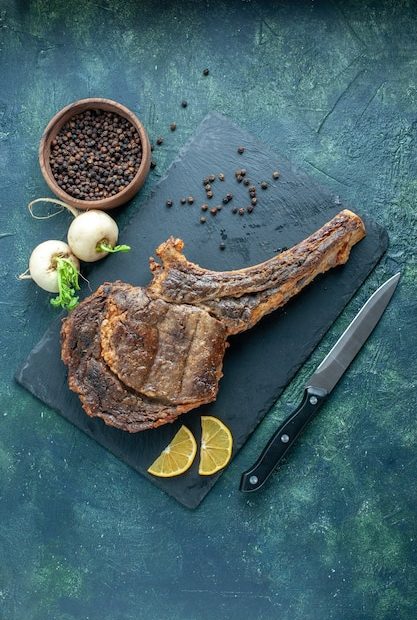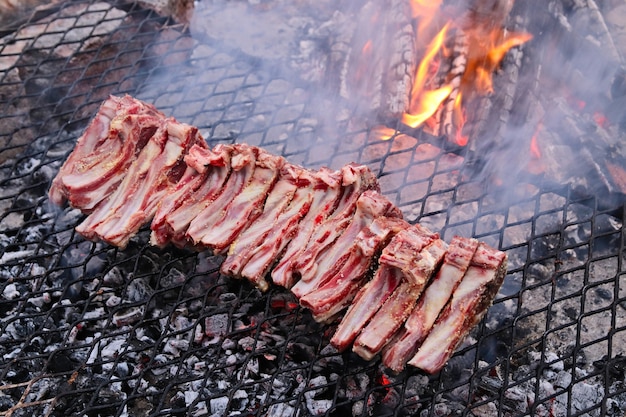How do you tenderize BBQ ribs?
Barbecue ribs are a popular dish enjoyed by many in the UK, especially during the summer months. The key to achieving deliciously tender and juicy ribs lies in the tenderizing process. By tenderizing the meat before cooking, you can ensure that the ribs are succulent and full of flavor. In this article, we will explore various methods and techniques to tenderize BBQ ribs, allowing you to create mouthwatering ribs that will impress your family and friends at your next barbecue cookout.
Methods for Tenderizing BBQ Ribs
1. Marinating: One of the most common methods used to tenderize ribs is marinating. Marinating involves soaking the ribs in a flavorful liquid for an extended period, allowing the meat to absorb the flavors and become more tender. Common marinade ingredients include vinegar, citrus juices, soy sauce, Worcestershire sauce, and spices. The acidity in the marinade helps break down the connective tissues in the meat, resulting in tender and flavorful ribs.
“Marinating involves soaking the ribs in a flavorful liquid for an extended period, allowing the meat to absorb the flavors and become more tender.”
2. Dry Rubs: Another popular technique for tenderizing ribs is using dry rubs. A dry rub is a mixture of herbs, spices, and seasonings that are applied to the ribs before cooking. The rub forms a flavorful crust on the meat and helps to break down the tough fibers, resulting in tender ribs. Common ingredients in dry rubs include brown sugar, paprika, garlic powder, onion powder, cayenne pepper, and black pepper. It is recommended to apply the dry rub to the ribs several hours before cooking to allow the flavors to penetrate the meat.
3. Slow Cooking: Slow cooking is another effective method for tenderizing BBQ ribs. By cooking the ribs low and slow, either in a smoker or in the oven, the collagen in the meat breaks down, resulting in tender and fall-off-the-bone ribs. This method requires patience, as the ribs will need to cook at a low temperature for several hours. However, the end result is well worth the wait.
Tips for Tenderizing BBQ Ribs
1. Remove the Membrane: Before cooking the ribs, it is crucial to remove the membrane that covers the bone side of the rack. The membrane can be tough and chewy, preventing the flavors from penetrating the meat. To remove the membrane, gently lift one corner with a knife or a pair of tweezers, then grab hold of it with a paper towel and pull it off in one piece.
2. Use a Meat Tenderizer: If you want to further enhance the tenderness of your ribs, consider using a meat tenderizer. A meat tenderizer is a tool with small blades or spikes that pierce the meat, breaking down the fibers and making it more tender. Be sure to use caution when using a meat tenderizer and follow the manufacturer’s instructions.
3. Consider Parboiling: Parboiling, or partially boiling the ribs before grilling or smoking, is a technique that can help tenderize the meat. By parboiling the ribs, you are pre-cooking them, which helps break down the collagen and make the meat more tender. However, this method may result in some loss of flavor, so be sure to season your ribs generously before and after parboiling.
In conclusion, tenderizing BBQ ribs is an essential step to achieve mouthwatering, fall-off-the-bone goodness. Whether you choose to marinate, use dry rubs, slow cook, or employ a combination of techniques, the result will be tender and flavorful ribs that will impress your guests. So go ahead, try out these methods, and elevate your BBQ rib game to the next level.
How do I make my ribs more tender?
Ribs are a classic dish loved by many, and there’s nothing quite like sinking your teeth into tender, flavorful meat. If you’ve ever wondered how to achieve that perfect fall-off-the-bone texture, we’ve got you covered. Here are some tips and tricks to make your ribs more tender:
Choose the right type of ribs:
When it comes to ribs, there are various cuts to choose from, including baby back ribs, spare ribs, and St. Louis style ribs. Baby back ribs are known for their tenderness and delicate flavor, making them a popular choice. Spare ribs and St. Louis style ribs have more fat and connective tissue, which can result in a juicer and more flavorful end product.
Remove the membrane:
The membrane is a tough layer on the underside of the ribs that can prevent flavors from penetrating the meat. To enhance tenderness, remove this membrane before cooking. Gently insert a knife under the membrane and loosen it, then use a paper towel to grip and peel it away.
Apply a dry rub or marinade:
A dry rub or marinade can add flavor and help tenderize the meat. A simple mixture of salt, pepper, garlic powder, and brown sugar can work wonders. Massage the seasoning into the ribs, ensuring an even coating, and let them sit in the refrigerator for at least a few hours or overnight.
Cook low and slow:
The key to achieving tender ribs is a slow cooking process. Whether you’re grilling, smoking, or baking them, low and slow is the way to go. This allows the collagen in the meat to break down gradually, resulting in tender, juicy ribs. Aim for a cooking temperature of around 225°F (107°C) and cook for several hours until the meat is tender.
Wrap in foil:
Wrapping the ribs in foil during the cooking process can help retain moisture and further tenderize them. This technique, known as the “Texas crutch,” involves tightly wrapping the ribs in foil, then returning them to the heat until they reach the desired tenderness. Alternatively, you can use butcher paper for a similar effect.
Rest before serving:
Allowing the cooked ribs to rest before serving is essential for maximum tenderness. Resting allows the juices to redistribute throughout the meat, resulting in a more flavorful and tender final product. Cover the ribs loosely with foil and let them rest for around 10-15 minutes before cutting into them.
By following these tips and techniques, you can elevate your rib game and achieve mouthwatering tenderness every time. Experiment with different rubs, sauces, and cooking methods to find your perfect combination.
Do Ribs Get More Tender the Longer They Cook?
When it comes to ribs, the longer they cook, the more tender they become. Slow cooking is key to achieving mouthwatering, fall-off-the-bone ribs that are packed with flavor. Whether you’re grilling, smoking, or using the oven, giving your ribs plenty of time to cook low and slow allows the meat to break down and become tender.
Types of Ribs
There are different types of ribs, each requiring a specific cooking method to achieve the desired tenderness. The most common types of ribs include:
- Spareribs: These larger, meatier ribs take longer to cook and benefit from slow cooking methods.
- Baby Back Ribs: These smaller, leaner ribs are quicker to cook but can still benefit from longer cooking times to achieve maximum tenderness.
The Science Behind Tender Ribs
When you cook ribs for an extended period at a low temperature, the collagen in the meat slowly breaks down into gelatin, resulting in tender, juicy ribs. This collagen breakdown requires time, typically several hours, to ensure that the ribs are properly cooked and tender. The longer you cook them, the more collagen will break down, resulting in even more tender ribs.
The Benefits of Low and Slow Cooking
Low and slow cooking has numerous benefits when it comes to ribs:
- Tenderness: Slow cooking allows the connective tissues to break down, resulting in tender and juicy meat.
- Flavor Development: The long cooking time allows the flavors of your chosen rub or marinade to penetrate the meat for a more flavorful eating experience.
- Fall-Off-The-Bone Ribs: The extended cooking time ensures that the meat is cooked through and easily comes off the bone.
In conclusion, yes, ribs do get more tender the longer they cook. Whether you choose to grill, smoke, or bake your ribs, make sure to give them plenty of time to cook low and slow to achieve the ultimate tenderness and flavor.
“Slow cooking is the secret to achieving perfectly tender ribs.”
Why are my ribs not falling off the bone?
One of the key disappointments when cooking ribs is when they don’t have that melt-in-your-mouth tenderness and the meat isn’t falling off the bone. This can happen for a variety of reasons, but fear not, we’re here to help you troubleshoot and achieve perfectly tender ribs every time.
1. Lack of Proper Cooking Time
One common mistake is not giving the ribs enough time to cook low and slow. Ribs need to be cooked at a low temperature for an extended period to break down the collagen and connective tissues. Ensure you are following a tried and tested recipe that specifies the cooking time and temperature.
2. Too High Heat
Cooking ribs at too high heat can cause them to become tough instead of tender. It’s important to maintain a consistent low temperature throughout the cooking process. Consider using a smoker or indirect grilling methods to achieve a slow and even cook.
3. Insufficient Marinade or Seasoning
The flavor and tenderness of ribs often come from well-marinated and seasoned meat. Make sure to marinate your ribs for an adequate amount of time to allow the flavors to penetrate the meat. Consider using a marinade containing acidic ingredients like vinegar or citrus juices, as they help tenderize the meat.
4. Not Removing the Membrane
Ribs have a thin membrane on the bone side that can prevent flavors from penetrating and hinder the tenderizing process. It’s crucial to remove this membrane before cooking. Use a knife or your fingers to loosen the edge of the membrane, then grab it with a paper towel and pull it off in one piece.
5. Insufficient Resting Time
Resting your ribs after cooking allows the juices to redistribute and the muscle fibers to relax, resulting in a more tender and flavorful meat. Wrap the cooked ribs in foil and let them rest for at least 10-15 minutes before serving.
Remember, achieving fall-off-the-bone ribs takes practice, patience, and attention to detail.
By following these tips, you’ll be well on your way to mastering the art of tender and flavorful ribs that will impress your friends and family at your next barbecue. Experiment with different techniques, marinades, and cooking times until you find the perfect combination that suits your taste.


